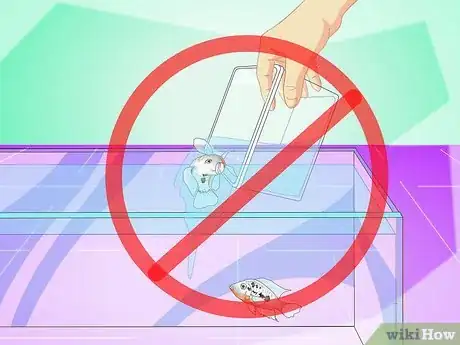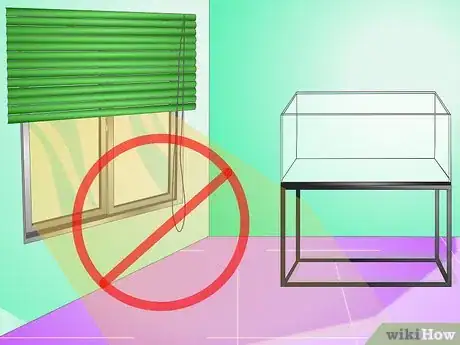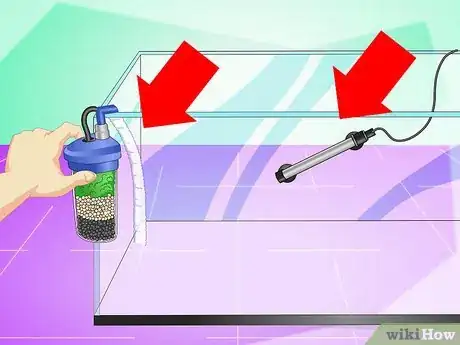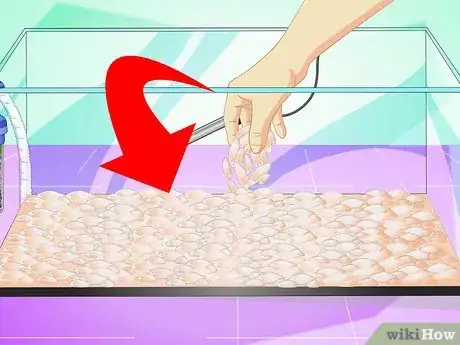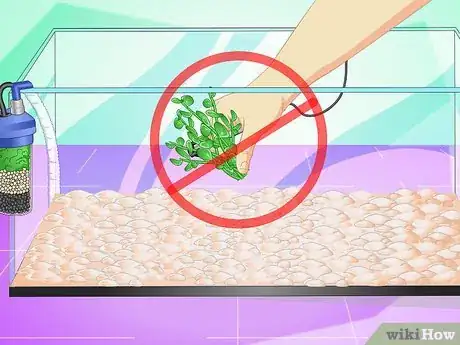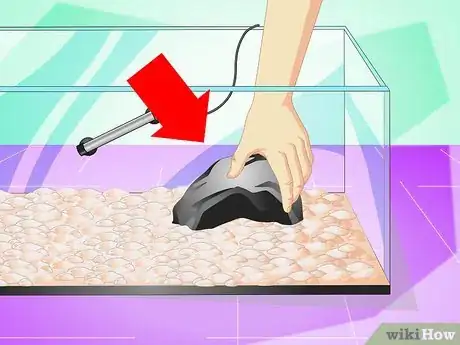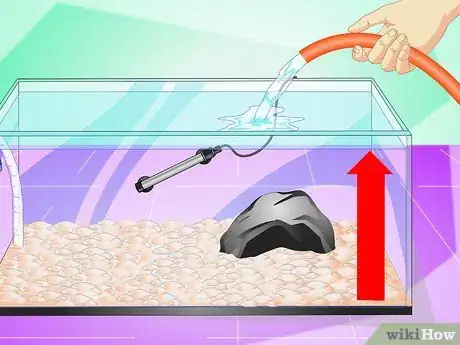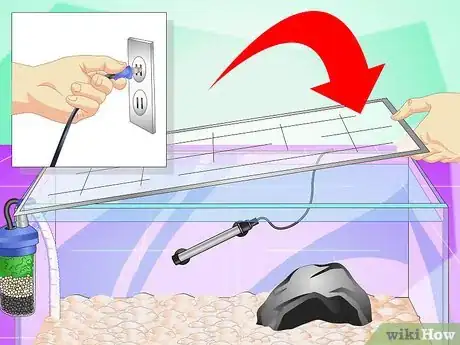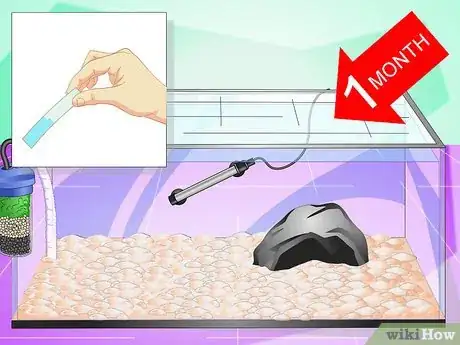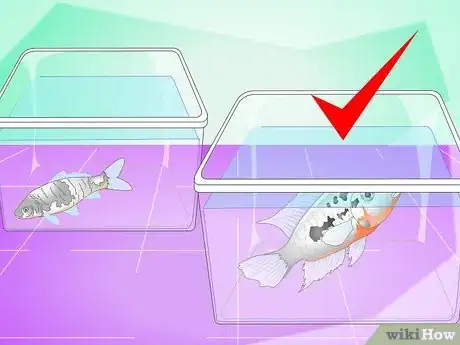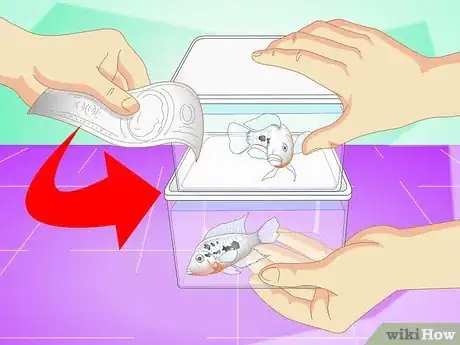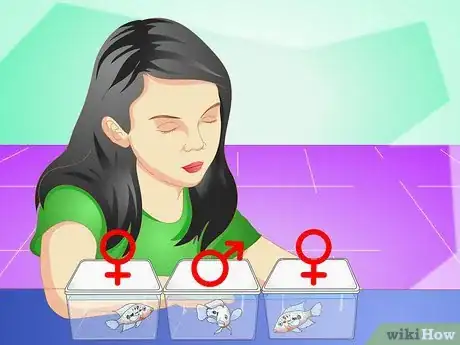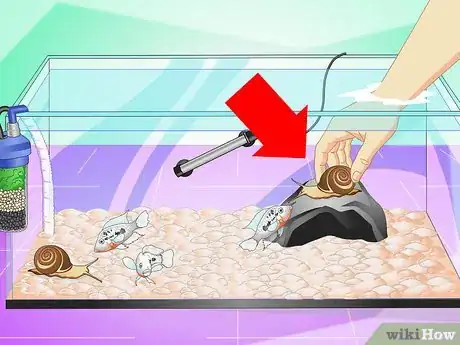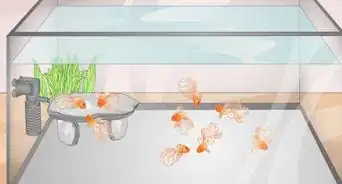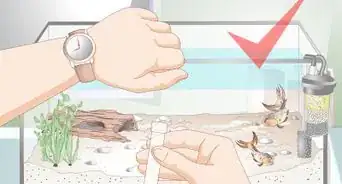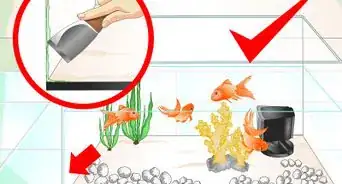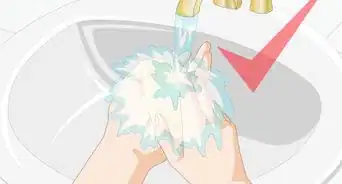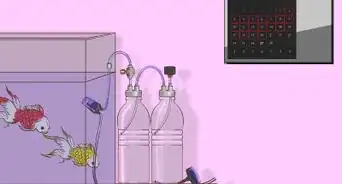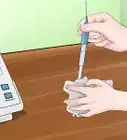This article was co-authored by Marshall Stephens. Marshall Stephens is an Aquarium Expert at Private Oceans Aquariums in West Palm Beach, Florida. Marshall has over 20 years of experience in the aquarium industry and focuses on captive-bred animals. They specialize in tropical and marine aquariums and are a contributor to the Loggerhead Marine life center in Jupiter Florida.
wikiHow marks an article as reader-approved once it receives enough positive feedback. In this case, 100% of readers who voted found the article helpful, earning it our reader-approved status.
This article has been viewed 97,544 times.
Cichlids can be easy to take care of, but they are different from other types of freshwater fish in terms of behavior and water requirements. How you set up their tank is very important, and this article will show you how.
Steps
Preparing the Tank
-
1Plan ahead. It is not a good idea to add fish into your tank the instant you finish filling it up with water. In order to be safe for fish, a tank needs time to build up the good bacteria and establish a natural cycle. Plan on setting up your tank about a month before adding your fish.
-
2Get a large enough tank. Most cichlids grow to be 5 to 6 inches (cc centimeters) long, but some can grow up to 12 inches (cc centimeters) long. Plan on getting a tank that is at least 29 gallons (109.78 liters), although a 50 gallon (189.27 liters) tank would be better. Also, because cichlids like to hide amongst rocks, a long, low, horizontal tank would be better than a tall, thin, vertical tank.
- If you are starting out with a 29 gallon (109.78 liter) tank, you will need to upgrade to a larger tank after about 1 year as the fish grow larger.
Advertisement -
3Clean everything using hot water. Rinse your tank, gravel, and rocks under hot water. Do not use any soap or detergents. It would be a good idea to clean even store-bought and packaged items, as they usually contain dust and traces of chemicals that may be harmful to your fish.
- To clean your substrate, place it in a strainer, and rinse it with hot water until the water runs clear.
-
4Place the tank in a place that does not get too much sunlight. Live plants don't fare well in cichlid tanks, so sunlight is not necessary. Also, too much sunlight will encourage algae growth.
-
5Add the water filter and heater. Place the filter and heater in the back so that they will be hidden by rocks when you add them in. Also, try to place the heater near the water filter. The water current will help distribute the warmth throughout the tank.[1]
- Don't skimp on the filter. Cichlids can create a lot of waste. A good quality canister-style filter would be ideal, even for smaller tanks.
- Try to get a metal heater instead of a glass one. Cichlids like to move rocks about, which can easily break a glass heater.
Decorating the Tank
-
1Fill the bottom 2 to 3 inches (5.08 to xx centimeters) with a clean substrate. Try to choose pebbles for the substrate. It will look the most natural. Avoid using fine gravel, as it can easily by swallowed by larger cichlids.
-
2Don't worry about plants. Most plants don't handle the high pH levels and hard water necessary for cichlids. Usually, aquarium hobbyists will use plants to control nitrates. Because of the water requirements for a cichlid tank, this is not possible. Instead, hobbyists will control nitrate levels by changing the water regularly.
- Cichlids may also uproot or eat the plants.
-
3Choose some clean rocks with caves, pockets, or holes, and arrange them in your tank. This will give your fish some hiding places. To create the most natural look, try to use an odd number of rocks. Don't spend too much time and effort arranging your rocks. Cichlids like to excavate and move things around.
- Consider including some white limestone rocks to help maintain the proper pH levels.
- You can even use pieces of coral or small clay pots. Avoid driftwood, as it can change the water pH and hardness.
- To create more depth, consider placing the larger rocks towards the back, and the smaller rocks towards the front.[4]
-
4Fill the tank with water. To keep the water from disrupting the substrate too much, consider placing a plate on the substrate first. Use a rubber tube to siphon the water into the tank. Fill the tank until the water level is about 1 inch (2.54 centimeters) away from the top. This will ensure that your fish get enough oxygen.
- If you use a plate, be sure to take it out when you are done filling the tank.
- Do not add your fish yet. Make sure to add a tap water conditioner.
-
5Place the cover on the tank and plug everything in. Don't worry if the water flow churns up the sediments and makes everything cloudy. Things will settle down.
- Covers are good ideas for any fish tank. Not only do they help keep the water clean from dust, but they also prevent fish from jumping out.
- Because cichlid tanks don't have live plants, bright lights are not necessary. A soft light, however, can help bring out the colors of your fish.
Stocking the Tank
-
1Wait until the tank cycle has established before adding your fish. This can take anywhere from several weeks to a month. Perform a water test every week. When the nitrate and pH levels are appropriate for your fish, you can go to the fish store and buy your fish.[5] The specific pH, temperature, and water hardness levels will vary depending on the species and breed of cichlid, but listed below are the most common ones:
- The pH should be between 7.8 and 8.5. Some dwarf cichlids prefer a pH between 6.0 and 6.5.
- The water hardness should be between 10 and 15dH. If the area you live in has very soft water, you can add some aragonite.
- The temperature should be between 72°F and 82°F (22°C-28°C).
-
2Stick with only one species of cichlid. Cichlids tend to be aggressive even towards other species of cichlids. It might be a good idea to just choose one species and stick with it. The two main species are African and South American. There are many different breeds within each species, and it is generally safe to mix those.[6]
-
3Buy cichlids together when they are about the same size. This will help ensure that they all grow up to be a similar size. It is not a good idea to mix small and large cichlids together. Some of the larger ones may try to bully the smaller ones.
-
4Plan on having 2 female cichlids for every male. This will prevent aggression and fighting among the males. It may also help prevent aggression towards female cichlids as well.
-
5Choose tank mates with care. Many fish do not do well in a cichlid tank, partly due to the high pH, acidity, and water hardness required for cichlids to flourish. Another reason many fish do not do well in a cichlid tank is because of how large and aggressive cichlids can get. Many hobbyists have witnessed cichlids bullying and even eating smaller fish.[7]
-
6Consider adding a bottom feeder. A snail, such as an apple snail, would be great for keeping the walls of your tank clean. A bottom feeder, such as a plecostomus, would be great for keeping the substrate clean. The plecostomus is an appropriate tank mate for a cichlid because it has thick skin and sharp spines.
Expert Q&A
-
QuestionHow do you raise the pH of a cichlid tank?
 Marshall StephensMarshall Stephens is an Aquarium Expert at Private Oceans Aquariums in West Palm Beach, Florida. Marshall has over 20 years of experience in the aquarium industry and focuses on captive-bred animals. They specialize in tropical and marine aquariums and are a contributor to the Loggerhead Marine life center in Jupiter Florida.
Marshall StephensMarshall Stephens is an Aquarium Expert at Private Oceans Aquariums in West Palm Beach, Florida. Marshall has over 20 years of experience in the aquarium industry and focuses on captive-bred animals. They specialize in tropical and marine aquariums and are a contributor to the Loggerhead Marine life center in Jupiter Florida.
Aquarium Specialist There are a couple of different ways! You can use coral-based rocks, which naturally give off a high pH, or you can use coral-based substrate (which will also increase the pH). There are also pH increasers; generally, the powdered forms are best since they have minerals in them (as opposed to liquid pH increasers, which have no minerals).
There are a couple of different ways! You can use coral-based rocks, which naturally give off a high pH, or you can use coral-based substrate (which will also increase the pH). There are also pH increasers; generally, the powdered forms are best since they have minerals in them (as opposed to liquid pH increasers, which have no minerals). -
QuestionWhat is the best way to cycle a cichlid tank?
 Marshall StephensMarshall Stephens is an Aquarium Expert at Private Oceans Aquariums in West Palm Beach, Florida. Marshall has over 20 years of experience in the aquarium industry and focuses on captive-bred animals. They specialize in tropical and marine aquariums and are a contributor to the Loggerhead Marine life center in Jupiter Florida.
Marshall StephensMarshall Stephens is an Aquarium Expert at Private Oceans Aquariums in West Palm Beach, Florida. Marshall has over 20 years of experience in the aquarium industry and focuses on captive-bred animals. They specialize in tropical and marine aquariums and are a contributor to the Loggerhead Marine life center in Jupiter Florida.
Aquarium Specialist Once your tank is set up and running, get a bottle of ammonia, put it in the water, and test for waste (ammonia and nitrites would be the main things to look for). Over the course of a month, you would test on a weekly basis to see where your ammonia and nitrate levels are. After your ammonia is gone, the nitrate will start to go up—and after that, the nitrate is gone. Your cycle typically takes a month, though every tank is a little different. Once you've reached that stage, it's safe to add a couple of starter fish (fish that are hearty and not too expensive).
Once your tank is set up and running, get a bottle of ammonia, put it in the water, and test for waste (ammonia and nitrites would be the main things to look for). Over the course of a month, you would test on a weekly basis to see where your ammonia and nitrate levels are. After your ammonia is gone, the nitrate will start to go up—and after that, the nitrate is gone. Your cycle typically takes a month, though every tank is a little different. Once you've reached that stage, it's safe to add a couple of starter fish (fish that are hearty and not too expensive). -
QuestionHow do you clean a cichlid tank?
 Marshall StephensMarshall Stephens is an Aquarium Expert at Private Oceans Aquariums in West Palm Beach, Florida. Marshall has over 20 years of experience in the aquarium industry and focuses on captive-bred animals. They specialize in tropical and marine aquariums and are a contributor to the Loggerhead Marine life center in Jupiter Florida.
Marshall StephensMarshall Stephens is an Aquarium Expert at Private Oceans Aquariums in West Palm Beach, Florida. Marshall has over 20 years of experience in the aquarium industry and focuses on captive-bred animals. They specialize in tropical and marine aquariums and are a contributor to the Loggerhead Marine life center in Jupiter Florida.
Aquarium Specialist You clean a cichlid tank the same way you would clean any other aquarium. Once a month, do a 1/4 of a water change using a gravel siphon to clean the gravel or sand. Keep in mind that different cichlids have different water parameters—for instance, South American cichlids like a soft water with a lower pH while African cichlids like hard water with a high pH. Any algae in your cichlid tank can be cleaned off with an algae scraper for the glass, or you might have different fish that eat the algae and help you keep the tank clean.
You clean a cichlid tank the same way you would clean any other aquarium. Once a month, do a 1/4 of a water change using a gravel siphon to clean the gravel or sand. Keep in mind that different cichlids have different water parameters—for instance, South American cichlids like a soft water with a lower pH while African cichlids like hard water with a high pH. Any algae in your cichlid tank can be cleaned off with an algae scraper for the glass, or you might have different fish that eat the algae and help you keep the tank clean.
Warnings
- Be sure to keep Cichlids that are the same size or they could possibly die.⧼thumbs_response⧽
- Never use any kind of soap or detergents to clean your tank, rocks, or substrate. Doing so can kill your fish.⧼thumbs_response⧽
Things You'll Need
- Aquarium
- Gravel
- Rocks
- Water
- Filter
- Water conditioner
References
- ↑ http://www.fishchannel.com/freshwater-aquariums/species-info/cichlid/create-a-lake-tanganyikan-rift-tank.aspx
- ↑ http://www.petfish.net/kb/entry/430/
- ↑ http://www.thetropicaltank.co.uk/mbuna1.htm
- ↑ http://www.petfish.net/kb/entry/430/
- ↑ http://www.fishchannel.com/freshwater-aquariums/species-info/cichlid/create-a-lake-tanganyikan-rift-tank.aspx
- ↑ http://aquariuminfo.org/cichlid.html
- ↑ http://aquariuminfo.org/cichlid.html
About This Article
To set up a cichlid tank, start by placing it in an area that doesn’t get too much sunlight to avoid algae growth. Then, install a filter and heater next to each other in the back of the tank, so that the filter can help distribute the warm water. Next, fill the bottom of the tank with 2 inches of pebbles and arrange some larger rocks around the tank to give the cichlids hiding places. Finally, fill the tank with water, and run the heater and filter for several weeks, until the pH is between 7.8 and 8.5 to ensure that the water is safe for your fish. For tips on how to choose a species of cichlid for your tank, read on!
